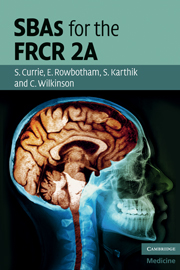Book contents
- Frontmatter
- Contents
- List of contributors
- Preface
- Introduction
- Module 1 Cardiothoracic and vascular
- Module 2 Musculoskeletal and trauma
- Questions
- Answers
- Module 3 Gastro-intestinal
- Module 4 Genito-urinary, adrenal, obstetrics & gynaecology and breast
- Module 5 Paediatric
- Module 6 Central nervous and head & neck
- References
- Index
Answers
Published online by Cambridge University Press: 06 July 2010
- Frontmatter
- Contents
- List of contributors
- Preface
- Introduction
- Module 1 Cardiothoracic and vascular
- Module 2 Musculoskeletal and trauma
- Questions
- Answers
- Module 3 Gastro-intestinal
- Module 4 Genito-urinary, adrenal, obstetrics & gynaecology and breast
- Module 5 Paediatric
- Module 6 Central nervous and head & neck
- References
- Index
Summary
1. b. Aneurysmal bone cyst
Aneurysmal bone cyst is most common in females and 75% occur under 20 years of age. The classic presentation is of pain of relatively acute onset with a rapid increase in severity over 6–12 weeks. Common locations include the spine, with a slight preponderance for the posterior elements, and the metaphysis of long bones – femur, tibia, humerus and fibula. The lesion is usually expansile with thin internal trabeculations giving it the characteristic soap-bubble appearance.
(Ref: Dahnert p. 45)
2. b. Pigmented villonodular synovitis
Pigmented villonodular synovitis is a relatively rare condition which usually presents in the third or fourth decade. It is a monoarticular, painful disease which causes a decreased range of movement at the affected joint. It is most common at the knee (80%) followed by the hip, ankle, shoulder and elbow. Haemorrhagic ‘chocolate’ effusion is characteristic. Low signal effusion on all sequences at MR is characteristic. There is no calcification or osteoporosis, and joint space narrowing is a late feature.
(Ref: Dahnert pp. 146–147)
3. c. Retropharyngeal space of 10 mm
This is too wide for the retropharyngeal space. The correct acceptable limits for soft-tissue measurements are as follows:
Predental space 3 mm in adults, 5 mm in children.
Nasopharyngeal space (anterior to C1) 10 mm.
Retropharyngeal space (C2–C4) 5–7 mm.
Retrotracheal space (C5–C7) 22 mm.
Disc spaces should be roughly equal throughout the cervical spine. Narrowing of a disc space is usually due to degenerative change, but widening would be a more concerning feature.
Information
- Type
- Chapter
- Information
- SBAs for the FRCR 2A , pp. 37 - 47Publisher: Cambridge University PressPrint publication year: 2010
